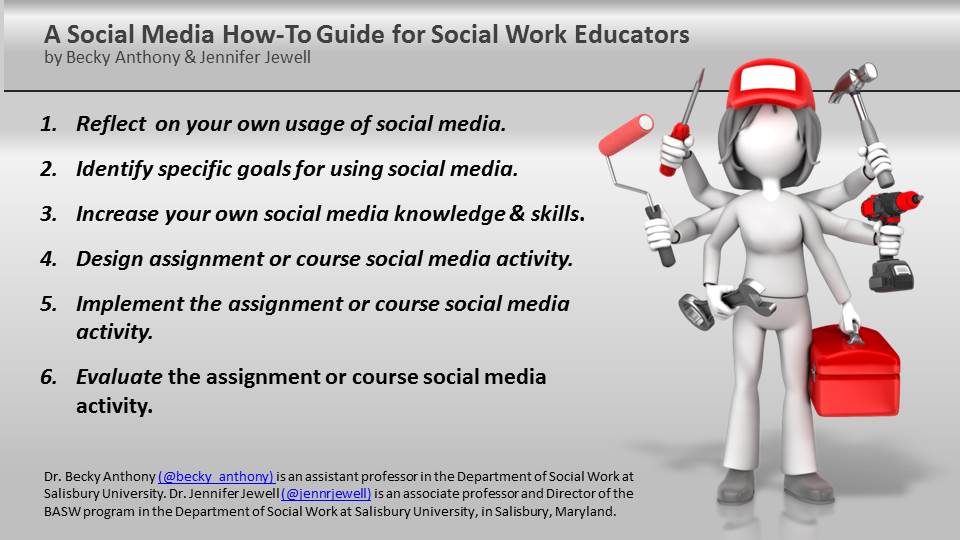Talking Technology Competency in the Social Work Classroom
Elise Johnson, LCSW is a clinical social worker at Long Beach Memorial Medical Center/Miller Children’s and Women’s Hospital of Long Beach. She has practiced social work in the L.A. area for over 20 years in the areas of health care, mental health, homelessness and child welfare. She is also a part time lecturer. She is by no means an expert in technology but is always on the lookout for technological innovations that could help clients and students. In this blog post, she writes about how she incorporates technology into her MSW courses.
I’ve been in the field of social work for nearly twenty five years, and I’ve been a lecturer for two and a half at California State University, Dominguez Hills. I teach two theory classes (Human Behavior I and II) in the MSW program. Given my clinical background, my overarching message in HBSE (Human Behavior and the Social Environment) is that theory is viable and applicable to contemporary social work practice. The incorporation of technology into my pedagogy is an important element of that framework. Integral to my teaching approach is the view that technology is an asset, an assistive value; one that should be viewed through a strengths-based lens similar to every other aspect of our profession. Initially, I decided to dedicate a week to the topic of technology in social work practice, and over the last couple of years, I have updated long-standing assignments by embedding them technology-based elements. For example, first year MSW students are developing competencies conducting bio-psychosocial assessments in other courses, In HBSE I, I encourage them to expand this traditional assessment to include an assessment of their clients’ technology literacy, access, strengths and risk factors across the lifespan. By integrating course content and assignments around technology in social work practice, students not only understand the role of technology in social work, they also learn to apply and practice with the very technology they may use in the real-world.
What Social Workers are saying about the NASW Draft Tech Standards?
 On June 20, 2016, the National Association of Social Workers along with Association of Social Work Boards, Council on Social Work Education and the Clinical Social Work Association released a draft copy of proposed new practice standards for technology in social work, and invited the public to comment and provide feedback. If you want to know what I did on my summer vacation this year, this was it! I worked with four different groups to draft comments, submitted my own comments, and advocated for all social workers to read and respond to NASW’s call for comments.
On June 20, 2016, the National Association of Social Workers along with Association of Social Work Boards, Council on Social Work Education and the Clinical Social Work Association released a draft copy of proposed new practice standards for technology in social work, and invited the public to comment and provide feedback. If you want to know what I did on my summer vacation this year, this was it! I worked with four different groups to draft comments, submitted my own comments, and advocated for all social workers to read and respond to NASW’s call for comments.
Feedback was due on July 20th, and now we wait for NASW and the other groups to respond, revise and/or release the final standards. Until then, I think there is value in sharing the comments and responses that were submitted to NASW. I have asked permission from a variety of individuals and groups to post their comments in this blog post. This is not a comprehensive list, but reflects the opinions of people and groups that I work with or know. Also, there is no particular order to the list; one set of comments is not more important than another set. Click on the links in the list to access a particular individual or groups’ comments. If you would like to add your feedback to this list, please contact me.
List of Comments to NASW’s Draft Tech Standards
– Technology Track for the Annual Program Meeting of Council on Social Work Education and Technology Committee of the Association of Baccalaureate Social Work Program Directors – These two committees combined their efforts and wrote one set of comments. I am a member of both committees.
– Dr. Robert Vernon is a Professor at Indiana University’s School of Social Work and is a pioneer in the use of technology in social work. His comments are available here.
Join the Convo – NASW needs feedback on Draft Technology Standards in SW
 I am so pleased that the draft Technology Standards for Social Work Practice have been released for public review. NASW, CSWE, CSWA, and ASWB developed a task force to collaboratively draft these technology standards, which you can access the draft standards here.
I am so pleased that the draft Technology Standards for Social Work Practice have been released for public review. NASW, CSWE, CSWA, and ASWB developed a task force to collaboratively draft these technology standards, which you can access the draft standards here.
I am working with several groups to provide comments to the task force and, I also plan to submit my own comments. Once adopted, these standards will be considered a model for best practice in social work. Given the important legal and ethical role that practice standards have in the professional lives of social workers, I believe it is essential to offer constructive and timely feedback on this document. I want to encourage everyone in the social work community to review and submit their feedback. You do not need to be a member of any group to offer feedback. The timeline is short for submitting comments – the one-month comment period closes July 20th.
Here are some highlights about the document. The draft standards and their interpretations are 82 pages. If you do not want to read 82 pages, you may want to know that these standards cover the following:
- Section 1: Provision of Information to the Public
- Section 2: Designing and Delivering Services – Part A: Individuals, Families, and Groups and Part B: Communities, Organizations, Administration, and Policy
- Section 3: Gathering, Managing, and Storing Information
- Section 4: Communication with and about Clients
- Section 5: Social Work Education (especially distance education)
Social Media How-To Guide for Social Work Educators
 This post was written by Drs. Becky Anthony and Jennifer Jewell. Dr. Becky Anthony (@becky_anthony) is an assistant professor in the Department of Social Work at Salisbury University. Dr. Jennifer Jewell (@jennrjewell) is an associate professor and Director of the BASW program in the Department of Social Work at Salisbury University, in Salisbury, Maryland. In this blog post, they write a guide for how social work educators can best utilize social media to meet their educational goals.
This post was written by Drs. Becky Anthony and Jennifer Jewell. Dr. Becky Anthony (@becky_anthony) is an assistant professor in the Department of Social Work at Salisbury University. Dr. Jennifer Jewell (@jennrjewell) is an associate professor and Director of the BASW program in the Department of Social Work at Salisbury University, in Salisbury, Maryland. In this blog post, they write a guide for how social work educators can best utilize social media to meet their educational goals.
With the changing nature of educational delivery and knowledge consumption, social work educators are increasingly utilizing social media to help students meet course learning goals and objectives. Students are able to use social media to network with social work professionals, enhance connections between peers, advocate and raise awareness about social concerns, and find resources that help them practice effective social work (Jewell & Anthony, 2016). Some social work educators want to utilize social media in their courses to help students meet learning goals, but are unsure about how to get started. This blog post reviews steps to help social work educators prepare and implement social media assignments and activities into the classroom.
STEP 1: Think about and reflect on your own usage of social media. You need to determine what you will do to abide by professional ethical standards, maintain your own personal boundaries, and explore how you will utilize social media. In this first step, you will create social media guidelines for the course, the department, and/or the professional self. Laurel Hitchcock provides an effective and thorough example of that here: My Guidelines for using Digital and Social Tech in the Classroom and Beyond. This first step allows you to learn about your own professional usage of social media and your own personal boundaries and professional ethics.
STEP 2: Identify specific goals for using social media in this course or with this specific assignment. Once goals are established, you will need to research the different tools (specific social media platforms). For example, Instagram is utilized to share photos and videos and Twitter only allows for 140 characters in each post. Social work educators, during step two, should answer the following questions: 1. What do you want the students to learn? 2. What social media method will work best to achieve this goal?
STEP 3: Increase your own social media knowledge and skills. Specifically, focus on the social media platform you will utilize in your course. You will find it helpful to create an account (if you do not already have one), watch tutorial videos online, utilize tip guides, and practice using this social media before asking your students to use it. This becomes very important because a number of students will not have previously utilized this social media platform and will ask you questions about how to get started and where to find resources.
Revised Technology-Based Learning Task List for Social Work Education
 Back in April 2016, Melanie Sage, Nancy Smyth, and I first shared a list of technology-based learning activities that we developed based on Council on Social Work Education’s Social Work Competencies from the 2015 Educational Policy and Accreditation Standards (EPAS). The purpose of this list is to help social educators infuse learning about and with technology across the social work curriculum. We have updated our list to keep with the evolving understanding of how to apply CSWE’s 2015 EPAS. Here are the main features of the list:
Back in April 2016, Melanie Sage, Nancy Smyth, and I first shared a list of technology-based learning activities that we developed based on Council on Social Work Education’s Social Work Competencies from the 2015 Educational Policy and Accreditation Standards (EPAS). The purpose of this list is to help social educators infuse learning about and with technology across the social work curriculum. We have updated our list to keep with the evolving understanding of how to apply CSWE’s 2015 EPAS. Here are the main features of the list:
– Over 100 different example assignments and learning tasks with brief directions that can be incorporated into social work courses across the curriculum.
– Assignments are designed to encourage students to share their work with a class/seminar or practicum field instructor.
– For assessment purposes, each assignment and learning task is grouped by competency and component behaviors, and then labelled with the relevant competency dimensions using the following key: K = Knowledge; V=Values; S= Skills; and CA = Cognitive and Affective Processes.
You can access the new version of the list here: Technology-Based Learning Task List for Social Work Education (Version 1.1 – 6/13/16)



